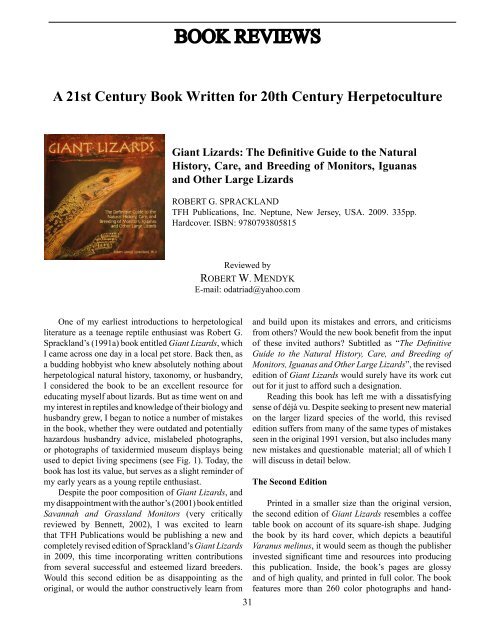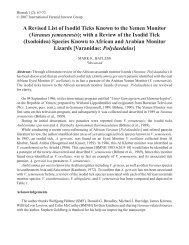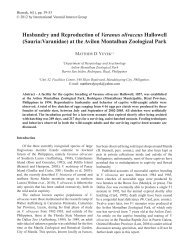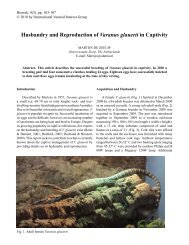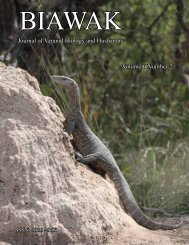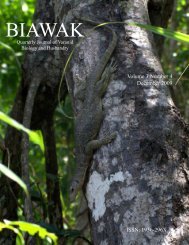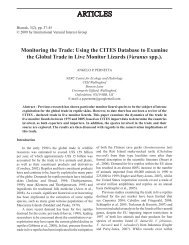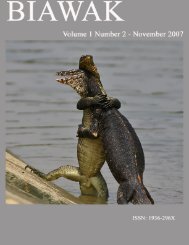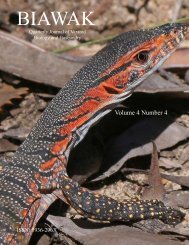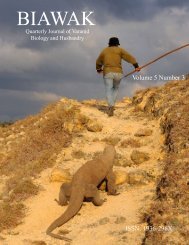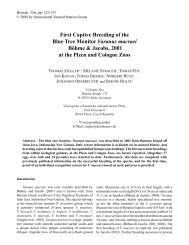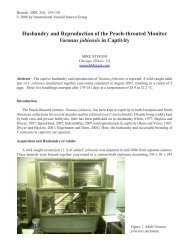Vol. 4 No. 1 - International Varanid Interest Group
Vol. 4 No. 1 - International Varanid Interest Group
Vol. 4 No. 1 - International Varanid Interest Group
You also want an ePaper? Increase the reach of your titles
YUMPU automatically turns print PDFs into web optimized ePapers that Google loves.
BOOK REVIEWS<br />
A 21st Century Book Written for 20th Century Herpetoculture<br />
One of my earliest introductions to herpetological<br />
literature as a teenage reptile enthusiast was Robert g.<br />
Sprackland’s (1991a) book entitled Giant Lizards, which<br />
I came across one day in a local pet store. Back then, as<br />
a budding hobbyist who knew absolutely nothing about<br />
herpetological natural history, taxonomy, or husbandry,<br />
I considered the book to be an excellent resource for<br />
educating myself about lizards. But as time went on and<br />
my interest in reptiles and knowledge of their biology and<br />
husbandry grew, I began to notice a number of mistakes<br />
in the book, whether they were outdated and potentially<br />
hazardous husbandry advice, mislabeled photographs,<br />
or photographs of taxidermied museum displays being<br />
used to depict living specimens (see Fig. 1). Today, the<br />
book has lost its value, but serves as a slight reminder of<br />
my early years as a young reptile enthusiast.<br />
Despite the poor composition of Giant Lizards, and<br />
my disappointment with the author’s (2001) book entitled<br />
Savannah and Grassland Monitors (very critically<br />
reviewed by Bennett, 2002), I was excited to learn<br />
that TFH publications would be publishing a new and<br />
completely revised edition of Sprackland’s Giant Lizards<br />
in 2009, this time incorporating written contributions<br />
from several successful and esteemed lizard breeders.<br />
Would this second edition be as disappointing as the<br />
original, or would the author constructively learn from<br />
Giant Lizards: The Definitive Guide to the Natural<br />
History, Care, and Breeding of Monitors, Iguanas<br />
and Other large lizards<br />
ROBERT g. SpRAcKLAND<br />
TFH publications, Inc. Neptune, New Jersey, uSA. 2009. 335pp.<br />
Hardcover. ISBN: 9780793805815<br />
Reviewed by<br />
ROBERT W. MENDYK<br />
E-mail: odatriad@yahoo.com<br />
31<br />
and build upon its mistakes and errors, and criticisms<br />
from others? Would the new book benefit from the input<br />
of these invited authors? Subtitled as “The Definitive<br />
Guide to the Natural History, Care, and Breeding of<br />
Monitors, Iguanas and Other Large Lizards”, the revised<br />
edition of Giant Lizards would surely have its work cut<br />
out for it just to afford such a designation.<br />
Reading this book has left me with a dissatisfying<br />
sense of déjà vu. Despite seeking to present new material<br />
on the larger lizard species of the world, this revised<br />
edition suffers from many of the same types of mistakes<br />
seen in the original 1991 version, but also includes many<br />
new mistakes and questionable material; all of which I<br />
will discuss in detail below.<br />
the second edition<br />
printed in a smaller size than the original version,<br />
the second edition of Giant Lizards resembles a coffee<br />
table book on account of its square-ish shape. Judging<br />
the book by its hard cover, which depicts a beautiful<br />
Varanus melinus, it would seem as though the publisher<br />
invested significant time and resources into producing<br />
this publication. Inside, the book’s pages are glossy<br />
and of high quality, and printed in full color. The book<br />
features more than 260 color photographs and hand-


